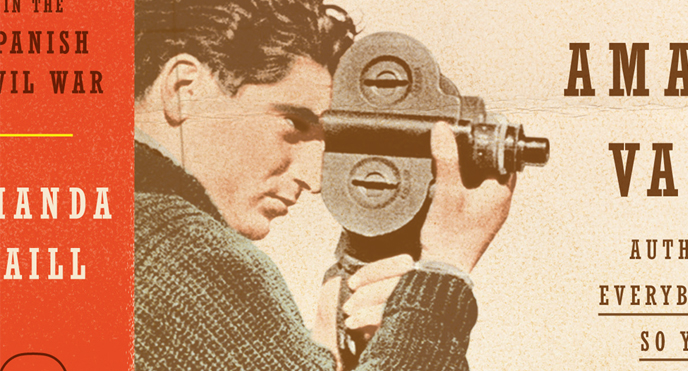The Dilemmas of an Overwhelmed Historian
It started with a quotation. “In those days,” wrote Ernest Hemingway, in a letter intended to publicize the 1939 premiere of his play The Fifth Column, “Herbert Matthews of The New York Times, Henry T. Gorrell of United Press, Sefton Delmer of the Daily Express, Martha Gellhorn of Colliers, Virginia Cowles, then for Hearst, now of the London Times, Joris Ivens, who made the ‘Spanish Earth,’ Johnny Ferno, who photographed it, Josephine Herbst for various American weeklies and for humanity in general, Sidney Franklin working for me, all International Brigade men on leave, and the greatest and most varied collection of ladies of the evening I have ever seen all lived at the Hotel Florida. . . . [Y]ou could learn as much at the Hotel Florida in those years as you could learn anywhere in the world.”
 |
I had been looking for a new book subject, circling around the 1930s, a decade of dangerous and fascinating transitions, when I read this letter in an article for The New York Times about an upcoming revival of The Fifth Column. Days earlier I’d seen a different news item about the discovery, in Mexico City, of a cache of Spanish Civil War negatives taken by the legendary combat photographer Robert Capa and remembered that Capa, too, had been at the Hotel Florida. Could his negatives, most of them never before seen, be a part of the story Hemingway’s letter suggested? Was this the beginning of a book idea?
Possibly. But I didn’t want to write a book that focused solely on foreigners in the Spanish Civil War. What I needed was the perspective of someone for whom the stakes were personal, not professional or political as they were for correspondents and the soldiers of the International Brigades who came to fight against Franco. By purest chance I found my man in a three-volume autobiography, The Forging of a Rebel, written by Arturo Barea, the chief foreign press officer in Madrid during the height of the war. Barea had known all the people Hemingway mentioned, as well as John Dos Passos, André Malraux, and others.
In addition, Barea had fallen in love with and ultimately married his deputy, a fiery Viennese crusader against fascism named Ilsa Kulcsar, and their love story was paralleled by that of Hemingway and Martha Gellhorn and Robert Capa and his lover and fellow photographer Gerda Taro. Suddenly, I had not only a venue, and a cast of main characters; I had a title, and a subtitle—all before I had written a word. Or I had most of one: the working subtitle was “Love and Death in the Spanish Civil War.” Truth, as we shall see, came later.
My research process, one I developed writing two previous biographies, is modeled on the old TV game show “Supermarket Sweep.” With the clock running (the book’s deadline looming), you hurtle through every relevant archive and secondary source, throwing anything that looks valuable, from love letters to passports to anecdotes, into your supermarket cart. With Hotel Florida, the contents were even more variegated than usual: I was dealing with material on six main characters and a host of lesser ones, not to mention a complicated stretch of European history. How would I ever keep it all straight?
I fell back on the old standby of grade-school history, the timeline. I created a chronology for every month of the Spanish Civil War, a line for every character, and an entity I referred to as “The War and the World.” I organized every notable factoid sequentially and slowly began to see the story unfold before me. The different characters’ timelines, month by month, suggested a narrative both complex and suspenseful—far more so than any thematic discussion. But I’d have to plot its course carefully, decide whom to follow and where to cut from one character to another. For the first time in my writing life (including my term papers in school) I did what my teachers used to tell me to do: I wrote an outline.
That was when I saw it: not only were there contrasts between the romantic and physical lives of my subjects, there were sometimes stark comparisons between the truthfulness with which they portrayed the conflict they witnessed, and their honesty about themselves and with each other. My outline revealed the real story of Hotel Florida and suddenly the book rose from the shopping cart of raw material. And I had the final word for my subtitle.
Read an excerpt of Hotel Florida…
Amanda Vaill is the author of, most recently, Hotel Florida: Truth. Love and Death in the Spanish Civil War. Her other books include the bestselling Everybody Was So Young: Gerald and Sara Murphy—A Lost Generation Love Story, which was a finalist for the National Book Critics Circle Award in biography, and Somewhere: The Life of Jerome Robbins, for which she was awarded a Guggenheim fellowship. In addition to her screenplay for the Emmy– and Peabody Award–winning public television documentary Jerome Robbins: Something to Dance About, she has also written features and criticism for a range of journals from Allure to The Washington Post Book World. She lives in New York City.
